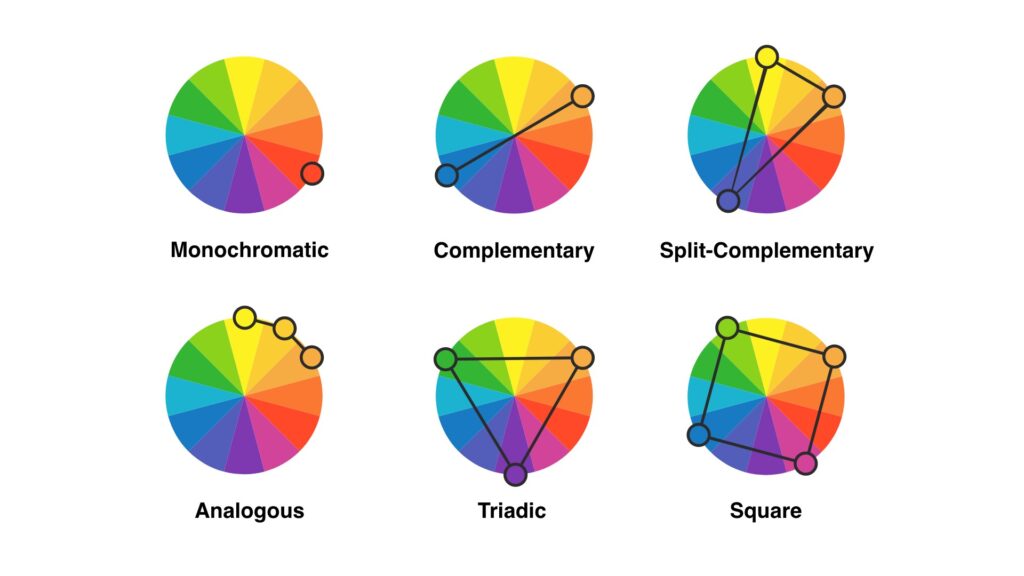Selecting the perfect paint color for your interior can be a daunting task. To help, I’ve broken it down into 6 simple steps that we’ve been using for the last 5 years to make it easy and effective!
1. Look At Current Colors.

So, the first step to getting the perfect color is to look through each room and find what colors stand out. What colors are currently being used in the furniture, rugs, or artwork that will remain in this room. We have to pull inspiration from these pieces since they will make up the room’s color palette. Write down any items that seem to have strong color pull, like a rug that has a unique color pattern or a focal art piece. Not all rooms have a focal point but if it does get it down on paper. Once you have all this down, jot down any color ideas you may have for this space while you are in it.
2. Research Color Schemes.
You don’t need to be a color expert to select great paint colors. Before you solidify your selection take a quick peak at the old trusty color wheel to ensure you understand how colors relate to one another. First, I’d like to point out that there are ultimately only six family of colors to choose from: Red, Orange, Yellow, Green, Blue, Purple. All those paint swatches at the paint stores are just shades or variations of these colors. With that in mind let’s look at a couple interesting color schemes(a color scheme is just a collection of colors that look good together).

3. Select Your Rooms’ Color Palettes.
Based on the information you’ve grabbed in the first step, and what you’ve learned in the second step, select a color scheme that works for each room. Usually this will mean selecting 1 paint color for the walls and the other 1 to 2 colors will be pulled from the furniture or art in the room. When you select a color scheme you should pay attention to what colors are being seen from that room, if any. If it’s an open floor plan you must relate colors of the whole room. If you have a large doorway in a room and you can see another room’s walls, that room must also match the room you are currently in. If you are less bold or don’t want to risk colors clashing, go with slightly different shades of a neutral color like gray or beige. Write down the each color family you’ve chosen for each room.
4. Grab Paint Samples.
Now that you’ve selected the base colors of each room, it’s time to grab swatches! Head to your favorite paint store, go to the paint swatch section of the store, and look through the colors that you’ve selected. Notice that, though you’ve drilled it down to one of the six color families, you still have many to chose from. Grab 2-3 colors from each base color that you like. Go to the front desk and ask for a sample of each color(these should be small cheap quarts of paint for you to put on the wall).
5. Paint The Samples On The Walls.

It’s very important that you paint your selections on your wall and leave them for 48 hours before you choose a winner. Since color is simply a reflection of light, your paint color will change based on the lighting. This means that throughout the day you will notice the color changes, depending on how much natural light is let into the room. Now, I could just say paint the samples onto the wall and leave it at that, but I’m a painter so I wouldn’t feel right with out giving you a couple tips. First, make sure when you paint the sample you use a mini roller rather than a brush. If you use a brush you risk leaving brush strokes, which will look terrible even after you paint your whole room. Second, Don’t paint the paint colors right next to one another, to avoid being able to see all the colors in your eye sight which will confuse your brain.
6. Select The Winners!
Once you’ve had some time to soak in the new colors, it’s time to pick the winner! Stand in front of the color, looking at it, and take notice of how it makes you feel. Is it calming? Does it invoke cheerfulness? Or does it seem to clash with you? Do this with each of the new colors and write your answers down. Using this as your guide, make your selection. Be confident—selecting interior paint colors is a personal process and only you(and your family) can make the decision on what is right for you.

Conclusion.
For most people, selecting paint colors is one of the more difficult tasks when planning to paint a house’s interior. But, by educating yourself and using the actionable steps I’ve laid out above, this doesn’t have to be you. So grab yourself a double shot of espresso and get started!
We’d love to know what paint colors you ended up with. Leave a comment below!
If you still feel like you need help choosing colors, our Interior Color Consulting services may be just what you need. Give us a call at 612-787-2583 or Click Here to Request a FREE Estimate.




